SUMMARY
This is AI generated summarization, which may have errors. For context, always refer to the full article.
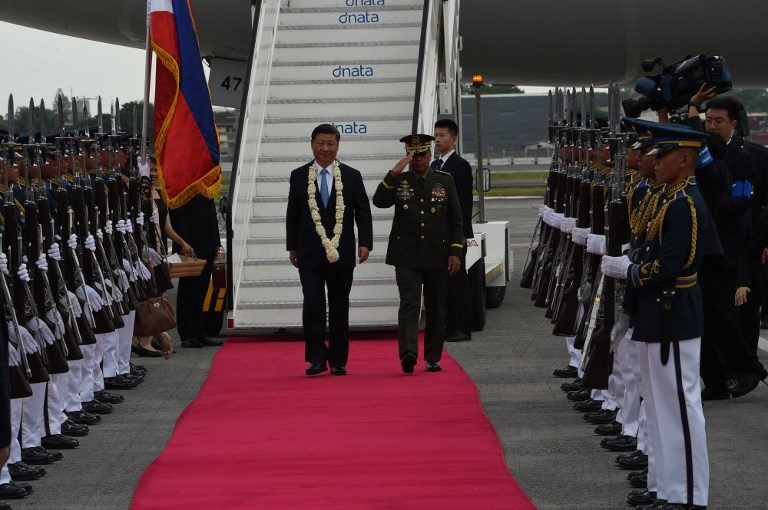
MANILA, Philippines – After stepping out of his plane to a cloudy Tuesday morning on November 20, China’s President gave his Filipino welcomers a small benevolent smile and slight wave of the hand.
However careful Xi Jinping may be with his body language, his arrival jolted the Philippines to attention. Here was the big man in the neighborhood, the regional power, coming to visit.
His first salute upon stepping on Philippine soil was from Armed Forces of the Philippines chief Lieutenant General Carlito Galvez Jr, whose Navy has had its share of tense moments with Xi’s own troops in the West Philippine Sea – and still do.
If the sea row – to many Filipinos the dominant issue in Philippines-China relations – was hardly alluded to in Xi’s presence, it dominated protests and online conversation.
The solemnity of Xi’s arrival was matched by shouts of “China layas!” (China, get out!) on streets near the Chinese consulate and the colorful irreverence of #XiJinPooh memes on the internet – a not-so-subtle dig at China’s infamous censorship practices.
To top it all off, a survey was released earlier that morning showing Filipinos continue to distrust China, compared to traditional allies like the United States and Japan.
But Xi’s itinerary in Manila, coupled by his astute and consistent messaging, was designed to emphasize, not the glaring differences and disagreements (noisy democracy vs obedient socialist republic, opposing maritime claims, Asian giant vs struggling 3rd world country), but the overlooked similarities and common interests.
Xi’s messaging: Jose Rizal and proverbs
As shots fired by honor guards rang out in Luneta, Xi closed his eyes for several seconds in front of the monument of Dr Jose Rizal, the Philippines’ national hero.
That afternoon, blazing red Chinese flags lined one side of the monument as Xi, like most foreign leaders coming to visit, offered a wreath to a symbol of national pride.
Rizal would become a recurring theme in Xi’s speeches during the state visit. He highlighted one particular characteristic of the hero – his Chinese roots. (WATCH: Xi Jinping, Duterte, and Rizal)
“Some of you may not know that his (Rizal’s) ancestry could be traced back to Jinjiang City in China’s Fujian Province,” he said at the Malacañang state banquet later that night.
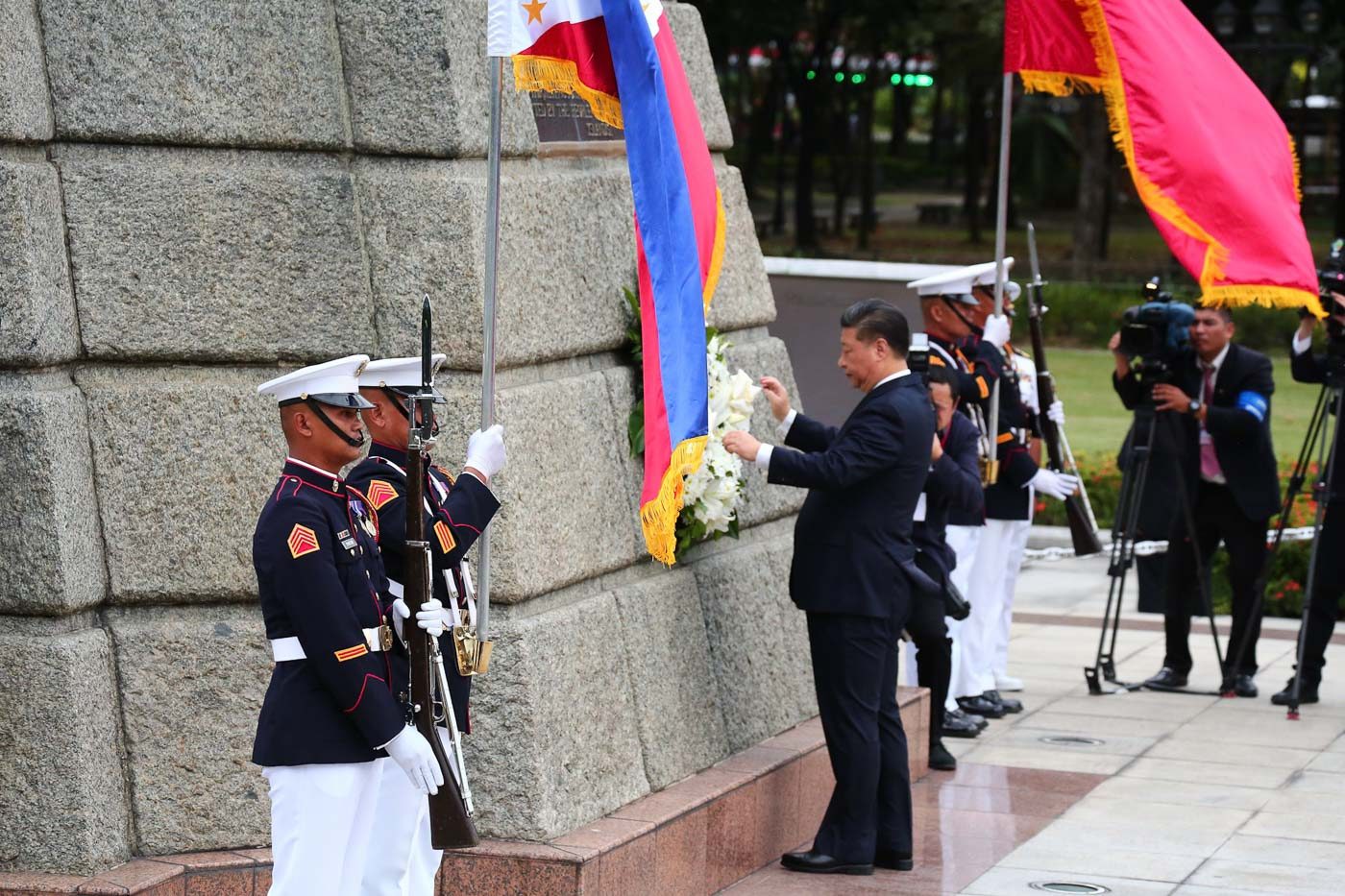
“Jose Rizal is not only the father of this nation but also a symbol of fraternal relations between the Philippines and China,” he added.
Xi spoke of Rizal as a personification of Philippine independence and praised Duterte for “taking on Jose Rizal’s mantle” with his battle cry to pursue an “independent foreign policy.”
For Xi’s purpose, Rizal was the perfect example of Filipino nationalism that could not deny Chinese heritage.
Xi ended up mentioning Rizal in two of his speeches in Manila – apart from an article he wrote before his arrival.
But he failed to mention another prominent Filipino with Chinese blood – Duterte’s predecessor and the former occupant of Malacañang. Former president Benigno Aquino III’s ancestors hail from Xiamen in Fujian province, in fact a province where Xi had served as governor.
Aside from invoking Rizal, Xi emphasized the Philippines’ and China’s geographic proximity. “Good neighborliness,” he said, is the “only correct choice” for the two countries to make.
In action: Duterte-Xi bromance
After paying homage to Rizal’s monument, Xi headed to Malacañang for his first interaction with Duterte during the visit.
All eyes were on the two. With the Malacañang events being livestreamed, optics reined supreme. Body language was everything.
There was definitely a lot to read into.
From their physiques alone, the two leaders could not be more different. The 5.9-feet Xi towered over Duterte. Almost a decade younger than the septuagenarian Philippine leader, Xi looked positively ruddy compared to Duterte, whose grey pallor could be seen behind his slightly distracting round-rimmed glasses.

Xi walked carefully and deliberately while Duterte shuffled a bit, especially as they walked together during the review of the honor guards. At its start, Duterte ambled behind Xi before he caught up as the red carpet turned a corner.
But past these differences, the two appeared to enjoy each other’s company. Xi was all smiles as he emerged from his car to shake Duterte’s hand. Duterte gestured animatedly with his hands as the two, along with presidential daughter Sara Duterte, walked towards Malacañang’s driveway, greeted at intervals by cultural dance performers.
Xi appeared particularly fascinated by the tinikling. Twice, he pointed to the bamboo sticks as they missed catching the female dancers’ nimble feet.
That walk humanized Xi in a way no speech could. There was even a moment when, as Xi went down the line of Cabinet members to shake their hands, Presidential Spokesperson Salvador Panelo broke formality by bringing out his phone to show Xi something on its screen.
Presidential Spokesman Salvador Panelo shows President Xi Jinping something on his smart phone. What could it be? #XiJinpingPH | RTVM screenshot pic.twitter.com/9NpnjfDlx3
— Pia Ranada (@piaranada) November 20, 2018
Xi, ever careful of his image and strict about protocol, managed a nod and a smile before moving on to shake the hand of Philippine Ambassador to China Chito Sta Romana.
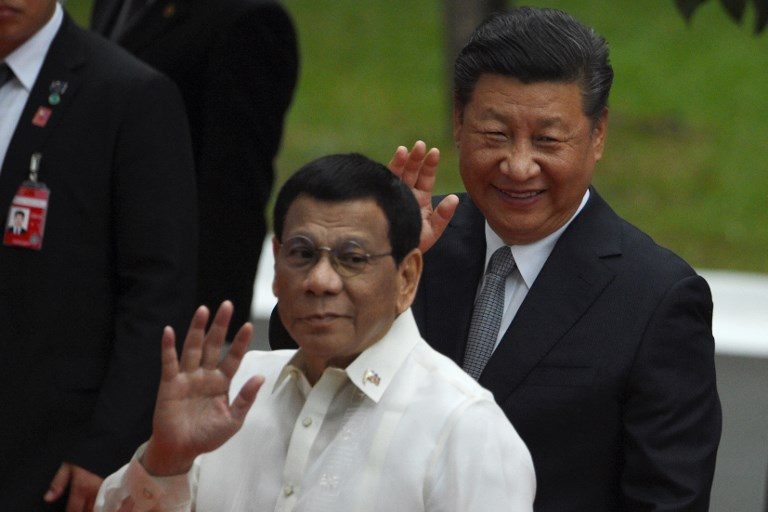
Filipino-Chinese take centerstage
Malacañang’s Rizal Hall, venue of the state banquet for Xi, was decked out in Christmas decor but the predominantly red colors also gave the impression of a Chinese theme.
Red poinsettia skirted the presidential table, a plush red carpet covered the heavy-wood floor, orbs of roses towered over round dining tables.
It was the perfect setting for a banquet attended by prominent Filipino-Chinese and Chinese nationals close to Duterte and his government.
Traditional state dinner guests were there – Cabinet members, ambassadors, lawmakers, business tycoons – but it was the Chinese connection that took centerstage.
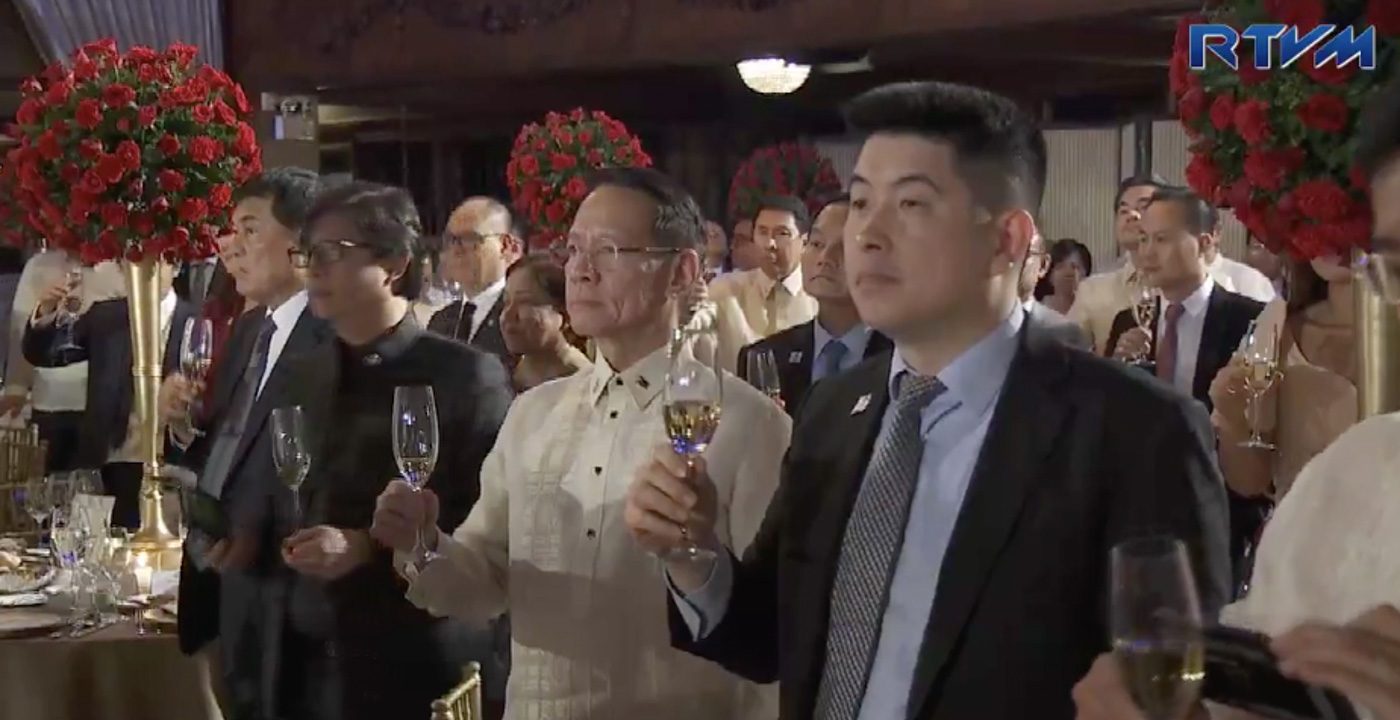
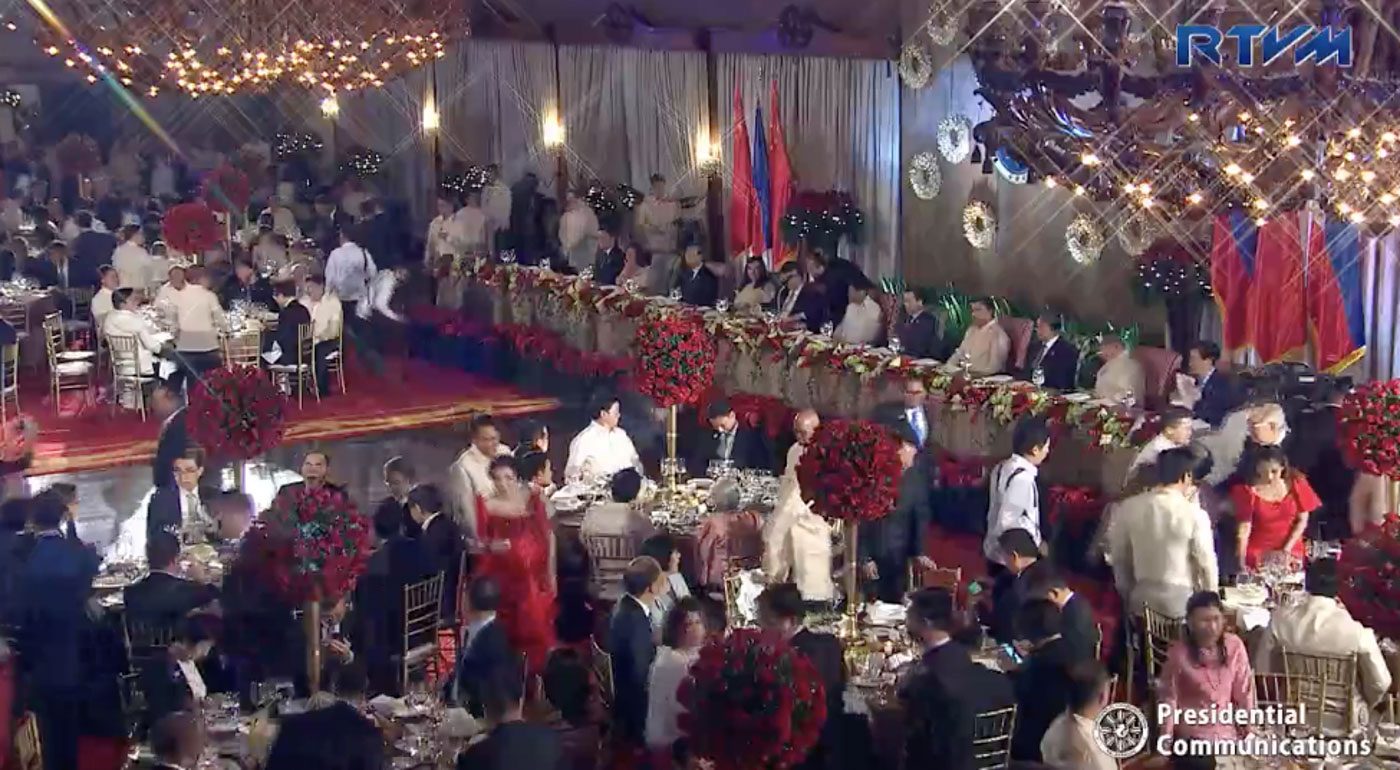
In attendance were Filipino-Chinese businessmen – Dennis Uy, Lucio and Michael Tan, the Sys, Carlos Chan, among others. Chinese nationals who’ve won Duterte’s trust – his consultant Michael Yang and drug rehabilitation center donor Jose Kho, were also there.
The event called to mind Duterte’s Chinese connection – his friendship with Filipino-Chinese businessmen in Davao City, their support for his presidential bid, and his frequent declarations that his grandfather is Chinese.
The next morning, Xi would meet leaders of the Filipino-Chinese community in his hotel for a photo opportunity. Even on the first day of his visit, some members of that community waited outside the hotel to catch a glimpse of him.
Some Filipino-Chinese families also gather outside the hotel, hoping to get a glimpse of Xi #XiJinpingPH @rapplerdotcom pic.twitter.com/RjuPRteTzM
— Sofia Tomacruz (@sofiatomacruz) November 20, 2018
Mysterious deals
But for those suspicious of Xi’s intentions, the pageantry of it all was beside the point.
What would the visit deliver in terms of concrete agreements and benefits for the Philippines?
The number of agreements signed was impressive – 29. This is more than double the number of deals signed during Duterte’s state visit to China in 2016 (13 agreements) and his visit to Russia (10 agreements).
Of the 29, ten were mere memoranda of understanding, 3 were agreements (including a loan agreement for the New Centennial Water Source-Kaliwa Dam Project), 2 were commercial contracts, and the rest were a mix of letters, importation protocols, and cooperation programs.
Duterte watched with hands together, elbows on his chair’s handles, as the seemingly interminable exchange of documents went on – with no gum-chewing this time, unlike during his first visit to Beijing.
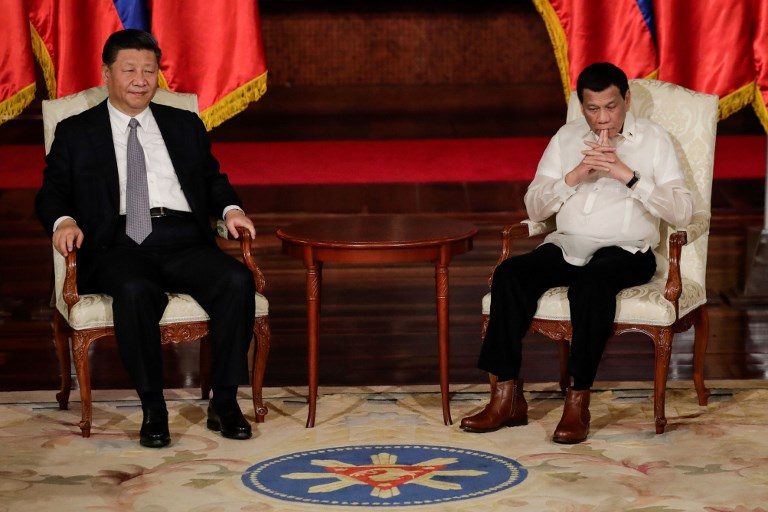
But the deal that dominated headlines was the MOU on oil and gas development. Because it pointed to joint exploration in the West Philippine Sea with China, which has not respected a legal decision in favor of the Philippines’ maritime claims, many wanted to know more about it.
Many voices, Vice President Leni Robredo and former foreign secretary Albert del Rosario among them, called on the administration to release a copy of the documents or to provide more information about them.
The insistent calls led Malacañang to promise that the government would release “pertinent information” to the public at the right time.
The opaqueness of the deals casts a shadow over the visit.
But perhaps the most all-encompassing and impactful of the agreements was the one not laid out in any contract. Xi and Duterte agreed they would “elevate” their countries’ ties up to a “comprehensive strategic cooperation.”
Xi’s last activity in Manila hearkened to another age of flourishing China-Philippines relations. On Wednesday, November 21, he held a meeting with Senate President Vicente Sotto III and House Speaker Gloria Macapagal Arroyo.
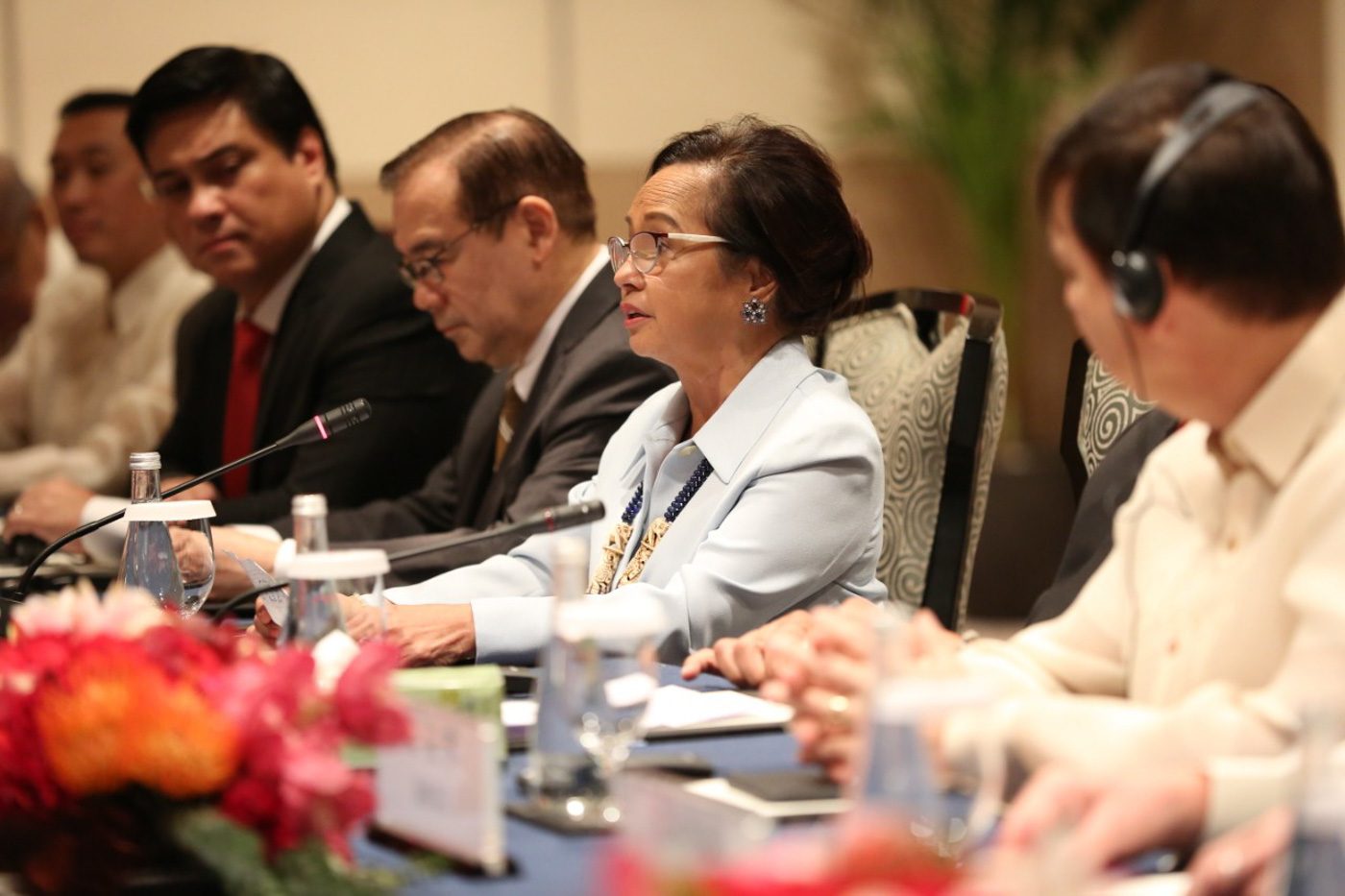
Arroyo’s presidency was the last time the Philippines enjoyed good ties with China. But it was also a time of shady deals, most memorable among them the NBN-ZTE deal, which had been mired in corruption allegations. A joint exploration deal signed then is being challenged in the Supreme Court.
At the meeting, Arroyo was all praises for Xi and China’s hard-to-match economic growth.
Adjustments for Xi
Like in most state visits, a degree of inconvenience for ordinary Filipinos could be expected. But perhaps not to the extent seen during Xi’s visit.
Two cities, Manila and Taguig, called off classes just for him. Road closures in both cities led to traffic and pesky rerouting.
There was another unprecedented adjustment.
Malacañang defied previous traditions for state visits by allowing the Chinese flag to be the lone flag that trailed Xi and Duterte during the review of the honor guards.
In all other past state visits, this was never done. Previous scenarios saw the use of only the Philippine presidential flag, the use of both the presidential flag and the flag of the visiting country, or no flag at all.
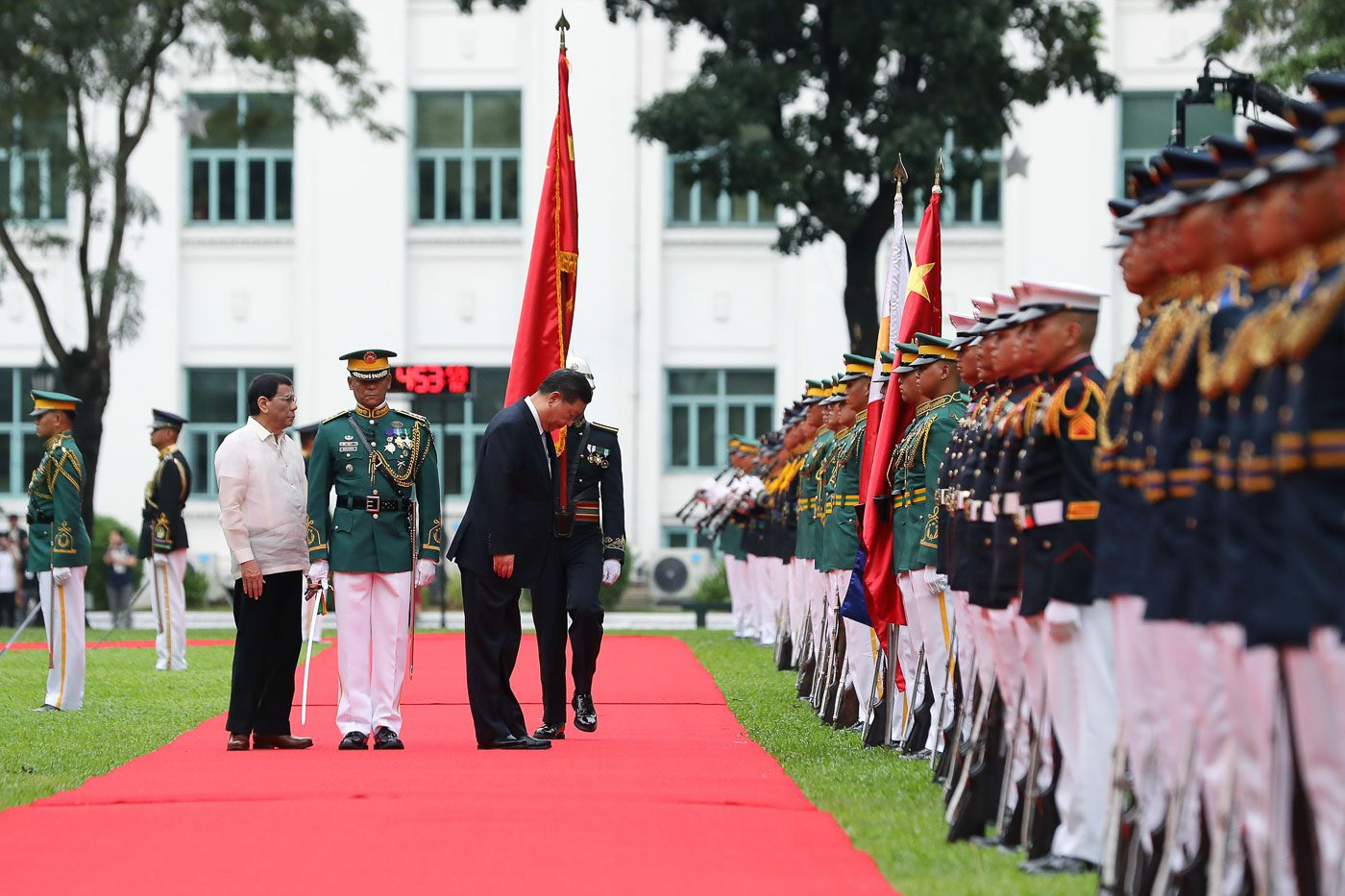
Historian and former Presidential Communications undersecretary Manuel Quezon III said the decision to use only the Chinese flag appeared intended to “give maximum prestige” to Xi, at the cost of tradition.
Photos of the Chinese flag taking centerstage in the Malacañang ceremony flooded social media during Xi’s last hours in Manila. They left many Filipinos asking, what does China want from its friendship with the Philippines?
By Wednesday afternoon, a weak but steady rain dampened the departure of Xi at the Ninoy Aquino International Airport.
Xi and Duterte are fond of using weather and climate as metaphors for improving Philippine-China ties – referring to a “springtime embrace” after a “cold winter” under the previous Philippine presidency.
A visit that began with a “refreshing breeze,” as described by Xi at the start of his bilateral meeting with Duterte, ended on a rainy day.
But cheerful blasts from trumpets dispelled the gloom of the weather as Xi walked up steps, with black umbrella in hand, into a plane that would take him back to his part of the neighborhood. – Rappler.com
Add a comment
How does this make you feel?
There are no comments yet. Add your comment to start the conversation.